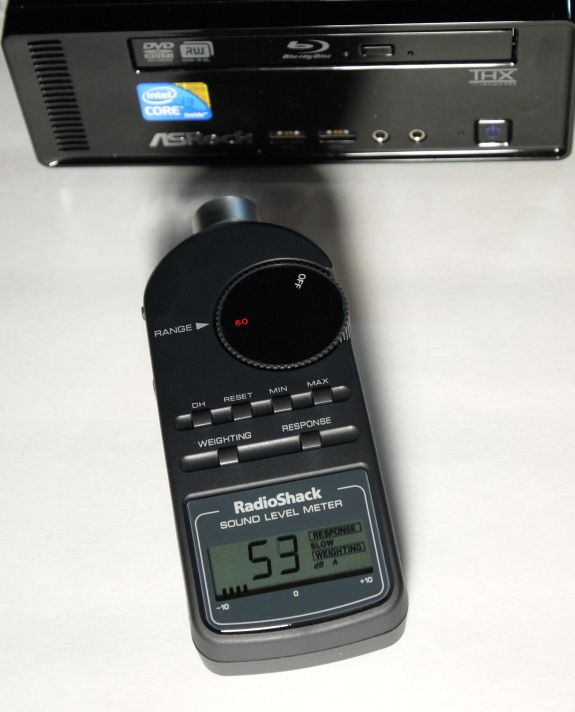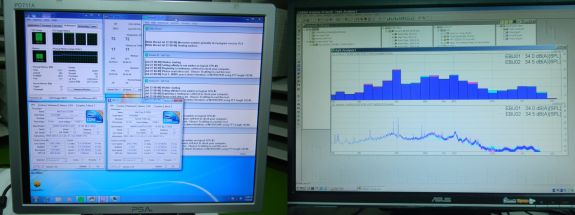ASRock Core 100HT-BD : Bringing HTPCs to the Mainstream Market [UPDATED : Noise Issue]
by Ganesh T S on July 19, 2010 9:34 PM EST- Posted in
- Home Theater
- Arrandale
- ASRock
- Media Streamer
- Core i3
- HTPC
HTPC enthusiasts are rightly concerned about the noise factor, heat and power consumption, ease of usage and many other criteria. We will tackle each of these concerns one by one in this section.
Noise
ASRock claims that the Core 100 HT-BD produces less than 25dB of noise. Under lab testing conditions, such performance is indeed possible. We decided to get hold of one of the sound meters used in setting up home theater speakers to verify whether the claims were true. Being a hobbyist sound meter, it wasn't very sensitive. The measurable sound range was only 50 - 130 dB, and there was a concern that the Core 100 would be too silent for the sound meter to pick up. As it turned out, while running Prime95 at full throttle (100% CPU utilization), the fans kicked in at full speed. The sound meter registered between 53 and 55 dB very close to the unit. [ See UPDATE below for a more practical measurement ]
The fan noise is quite audible if one sits very close to the unit. From 8 ft away, even with the unit in the open, we could barely hear it. Noise, however, is a very subjective issue. We hope the quoted number will help give readers an idea of how noisy the system gets when fully loaded. If the unit is going to be installed inside a cabinet of some sort, the noise factor becomes a non-issue.
UPDATE: One of the reasons we kept our sound detector very close to the unit was because it refused to register any measurement at the usual practical distances. While waiting to get hold of a more sensitive sound meter, we asked ASRock for lab results of sound measurement at full throttle. They were happy to oblige us with the following photographs and video from their anechoic chamber. It appears that the sound level is less than 35dB at a distance of 2 ft. even with all fans in action.
Power Consumption
In order to get an idea of the power consumption numbers, the Prime95 benchmark was let run overnight to keep the system completely loaded for an extended duration. All the four 'cores' of the CPU were pegged at 100% throughout, and we found an average power consumption of less than 48 W. At idle, the system consumed around 18 W.
These type of power consumption numbers have been enabled by ASRock's choice of going in for an Arrandale instead of a Clarkdale platform. This has resulted in a smaller form factor case design for the mini-ITX motherboard. Since there is not much heat to be dissipated, the cooling system is also appropriately small and silent.
Ease of Use
HTPC enthusiasts are concerned about how easy it is for their system to come out of standby. Existence of HDMI handshake issues upon return from standby is also a deal breaker for many. Fortunately, the Core 100 HT-BD has no issues in these two aspects. As long as the AC power adapter is connected to the system, the bundled MCE remote can be used to boot the system (even if the PC had been shut down previously). In order to shorten the boot times, ASRock supplies an Instant Boot utility. Using this, whenver the Core 100 HT-BD is shut down, it boots up once again and shuts down before the power can be safely removed. Upon power up, the boot up is instantaneous. If the user wants to put the PC in sleep mode, ASRock also supplies a Goodnight LED feature in the BIOS, which turns off the bright blue blinking LED in front. The MCE remote can also be used to bring the PC out of sleep mode.
Within Windows, the MCE remote can be made to work with a variety of applications such as XBMC, MediaPortal, MPC-HC and of course, Windows 7 Media Center. Blu Ray players such as PowerDVD and ArcSoft TMT can also be controlled with the help of the MCE remote. For the ideal I/O scenario, one probably needs to purchase a wireless keyboard / mouse combo.
It was seen in an earlier section that the Core 100 HT-BD happened to score quite well in the Anandtech Media Streamer Test Suite. The unit could playback all files using one program or the other, and people expect nothing else from a HTPC. Unfortunately, there is no single unified interface (from XBMC or MediaPortal or any other similar program) which could successfully play back all the files from within. There is definitely an ease of use issue existing here. However, this is not ASRock's fault, and will probably continue to exist on all Clarkdale / Arrandale platforms. Hopefully, projects such as XBMC's DSPlayer mature rapidly to alleviate this problem.













107 Comments
View All Comments
ck_mb - Tuesday, July 20, 2010 - link
Does the video card pass WMC cablecard test? I have a AMD 780G that doesn't, since this motherboard doesn't have any expanision slot it would be worthless as a dvr using cablecards.ganeshts - Wednesday, July 21, 2010 - link
Yes, the system passes the Digital Cable Advisor test without any issues.schoenbe - Wednesday, July 21, 2010 - link
An HTPC without a TV tuner is not an HTPC. It is a media player.In the case of the Core-100HT-BD reviewed here, a powerful media player. But you still can't watch TV with it. You cannot record TV with it. Not even a single channel, let alone several channels simultaneously. Anandtech should not recommend this unit as an HTPC. Besides, $700 for a media player? For playing back BD discs and media files? Not sure who wants to pay this much for an incomplete feature set.
DigitalFreak - Wednesday, July 21, 2010 - link
If you don't like it, don't buy it. Is someone standing there with a gun to your head?EnzoFX - Wednesday, July 21, 2010 - link
In my experience, USB tuners are the easiest for people to work with. This unit is targeted at people who probably wouldn't be willing to open up a computer case and install an internal tuner IMO. Personally, I think the best tuner is the HDHomeRun, which is a network based tuner, so this ASRock unit definitely delivers in every regard.schoenbe - Thursday, July 22, 2010 - link
"... this ASRock unit definitely delivers in every regard." Really? Even if you have to go out and buy a TV Tuner and make it work? This product definitely doesn't deliver the complete package.Ipatinga - Wednesday, July 21, 2010 - link
In the article, there is a part where it says "... One must also take into consideration the cost of the Atheros AR9287, which can be bought for around US $15 online..."Where can I find Mini PCI Express 1x Wireless Adapters (Half Height or not) like this Atheros AR9287 this cheap ($15)?
Thanks :)
ganeshts - Thursday, July 22, 2010 - link
This is the listing I was referring to:http://cgi.ebay.com/Atheros-Dual-Band-AR9287-Wirel...
cjs150 - Thursday, July 22, 2010 - link
Ganeshts: I think you and I have different definitions of noisy. Lets take a simple and real life example.I am listening to classical music - obviously a quiet section, the 1812 overture can be heard over a jet engine!
At same time I have firefox up and running (couple of tabs one of which is of course Anandtech but the other is a chess site I use)
I am also running a chess analysis program, fritz, which will take whatever CPU capacity you through at it
Pretty obviously under this scenario the IGP is not fully loaded but the CPU could be running close to capacity.
My Sofa is 6ft away.
If I can hear the ASRock then it is too loud. By comparison my main work rig (admittedly water cooled), I cannot hear other than possible a very slight noise of air movement.
We all know that manufacturer claims of noise levels are typically overstated (expecially by fan manufacturers) but to be suitable for me the noise (close to the machine) has to be sub 30db or even sub 25db. It is not difficult but does limit the cooling to a slow running 140+mm fan.
Mind you the loudest thing in the living room (apart from my daughter) has to be the cable set up box - but only when it starts up from sleep, some really bad design I think there
ganeshts - Thursday, July 22, 2010 - link
cjs150,Noise is a very subjective issue. What might be noisy to me might be OK to you, or vice versa. It is really hard to say what the "ideal" dB would be (aside from silent of course). Some people seem to have the hearing of a bat, while others are more tolerant.
For the correct judgement, you will have to experience it yourself, unfortunately.
The hobbyist sound meter we used could barely register anything unless it was very close to the unit (as you can see from the photo). At 2 ft away, manufacturer shows proof of 34.5 dB (Please check UPDATE section on Page 11).
I am not even sure there are professional sound meters to measure sub 30 and sub 25 dB unless you have an anechoic room.
The figures are presented, and in our opinion, at this cost and for this form factor, ASRock appears to have done the best it could do. Whether the figures are acceptable to you or not, I can't judge from here :)
Our review of this product was from the perspective of the average HTPC user ( not people with 7 TV tuners, for instance ;) )